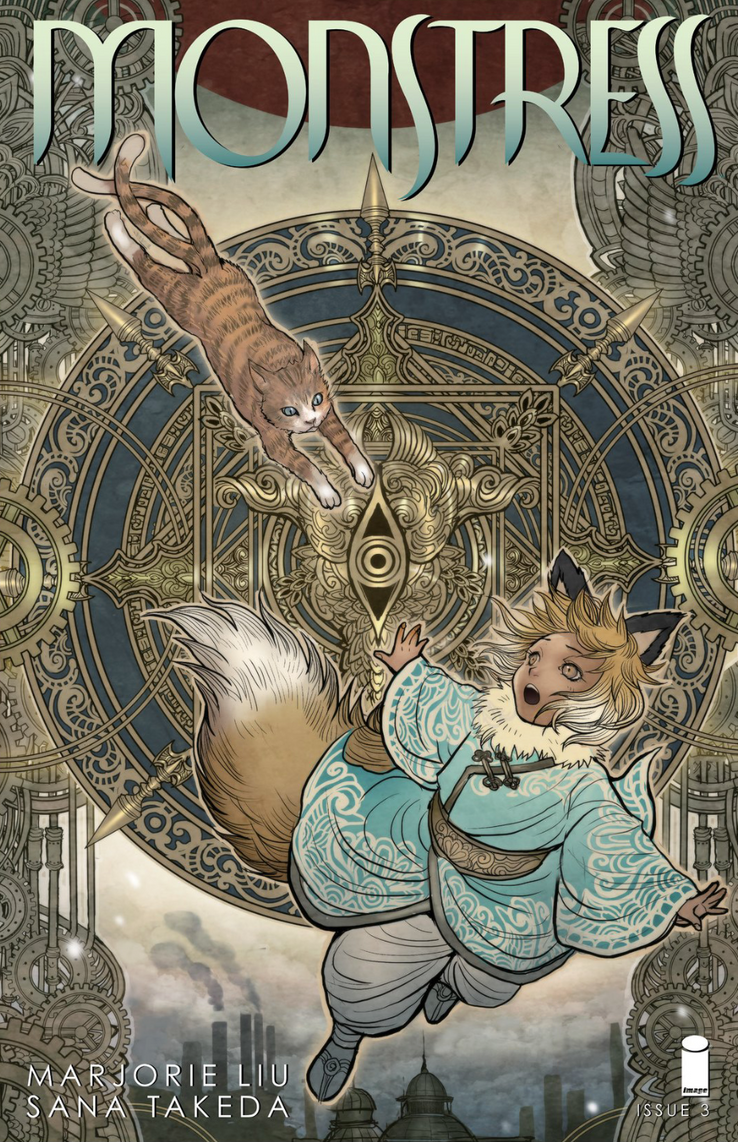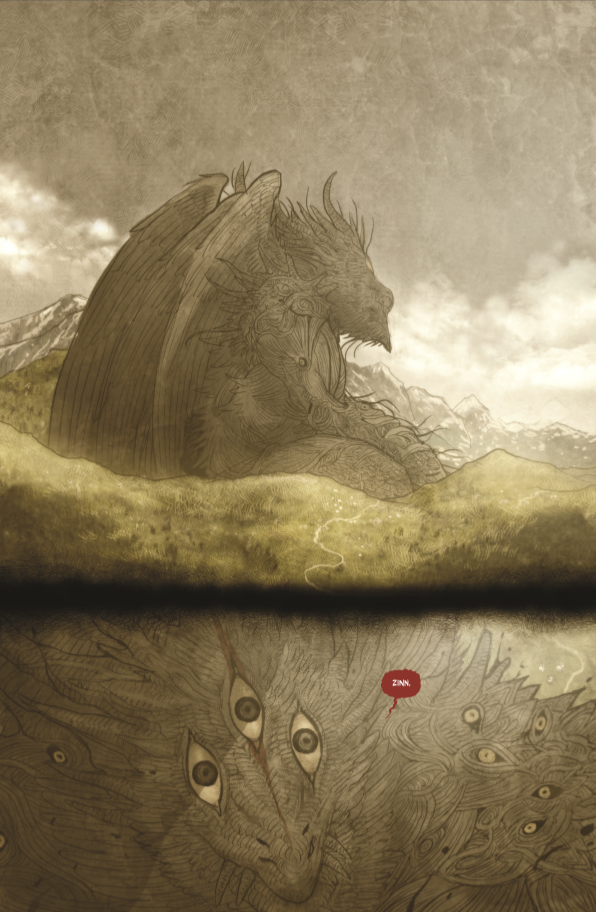Monstress is a serial graphic novel written by Marjorie Liu and illustrated by Sana Takeda, following the story of teenage girl Maika Halfwolf in what is described as “an alternate, matriarchal 1900s Asia brimming with arcane dangers” and on the brink of a species war. Since its release, it has garnered widespread praise from critics, won five Eisner Awards in 2018, as well as a Hugo Award and British Fantasy Award in 2017. It has also made Liu the first female to ever win the award of Best Writer. Currently, it comprises 24 issues collected into four volumes of six issues each.
I first encountered this series after a recommendation from a friend over our mutual love for epic fantasy. I did my own research into Monstress and became increasingly intrigued by the vivid worldbuilding and the Art Deco- and steampunk-inspired style of the work. After the first volume, I was hooked, and I recently picked up the fourth volume from the bookstore. I rarely purchase graphic novels, and this, to me, stands as a testament to Liu and Takeda’s genius. This article, then, is my way of evaluating and recommending Monstress to a broader audience.
To begin, Marjorie Liu has crafted an incredibly immersive and extensive fantasy realm to act as the backdrop of the story. While the world of Maika Halfwolf is mainly inspired by Asia, a blend of cultural influences is present in the design of clothing and locations. The Known World in the series also incorporates both modern and traditional technologies, styles of dress, and verbiage.
Monstress has been considered “as ambitious as George R. R. Martin or J. R. R. Tolkien” by the LA Review of books, and as an avid fan of Martin’s A Song of Ice and Fire series I can attest to that statement. ASOIAF, which is known for being one of the most acclaimed high fantasy series today and the source material for Game of Thrones, features an immensely detailed world complete with multiple sets of cultural conventions and diverse settings that play a part in how characters interact with one another.
Monstress does the same and creates a unique personality for each and every location, from the bustling port city of Thyria to the scientific capital of Zamora, ruled by the cumaea, or witch-nuns. The races that appear in the comic are also widely varied, from the demigod-like Arcanics to the bipedal Nekomancer (a wordplay on “necromancer” and the Japanese term for cat, “neko”) cats. Sana Takeda’s art is extremely intricate and her command of details helps to immerse the reader fully in Maika’s world.
…as ambitious as George R. R. Martin or J. R. R. Tolkien…

Liu and Takeda also excel at character design. In an interview with The Atlantic, Liu expresses that Maika Halfwolf’s defining quality is anger, and she took inspiration for this from society’s view of female rage. “Angry women are called bitches, too emotional, hysterical, whereas male rage is often portrayed as heroic, righteous, intelligent,” she says. “Women need rage to survive in society, but female rage without a project of emancipation, in the long run, might not be as rewarding as we want it to be.”
Throughout the four volumes of Monstress currently available, the reader witnesses Maika’s complexity of emotions as she attempts to right what she sees as injustices, all the while struggling against a legacy she neither asked for nor can truly bear to part with. We are able to see her as both who she sees herself and how others see her, and we also experience her inner conflict. Is she the monster or victim to one? Is her monstrosity the product of her past or simply a part of her? And does she have a say in how it defines her?
Maika is joined by a cast of supporting characters that are every bit as compelling as she. There is the Monstrum Zinn, who inhabits Maika’s body and fights her for control, the innocent fox girl Kippa, and the two-tailed cat Ren Momorian. Personally, I found Kippa’s character arc particularly gripping; after being saved from the witch-nuns by Maika, she becomes Maika’s companion and bears witness to the best and worst moments of our heroine. Kippa’s optimism even in the face of Maika’s brutality paint her as incredibly loyal and optimistic, but it soon becomes apparent that she isn’t naive, either. She understands Maika’s struggle for control and recognizes, despite what her trauma has made her, that Maika is not evil.
If you abandon your friends to a monster, you fail them forever.

Visually, too, the characters are stunning. From the animal-human hybrids that are the Ancients and Arcanics to the “old gods,” the Monstra, every single character that appears in Monstress is visually intricate and refreshingly creative. As mentioned previously, Takeda’s art is heavily inspired by both Eastern and Western attire and incorporates elements of East Asian mythology, steampunk, and Art Deco. In depicting the Ancients and Arcanics, she blends the human and animal together seamlessly, and one could almost expect such a being to exist in real life. The Monstra are hauntingly beautiful and so detailed that it is difficult to even begin to imagine how long drawing a single Monstrum might take.

One also notices after a few pages, when reading Monstress, that male and white characters are few and far between. Almost every single character in the series is female and coloured. When asked about it, Liu responded, “Monstress is my response to and a product of my frustration with being bombarded by stories I’m told I should be grateful for. Like when we see TV shows where there are like a million white people and one Chinese woman, if we’re lucky.
“It’s a lie of white supremacy—the visual lie that tells us our heroes, our stories, our love lives, and everything that we aspire to, everything that is heroic and romantic, is white. Being surrounded by that, I think, really deforms the imagination, and it deforms the heart as well.”
As a Chinese born in China but raised here in Canada, I can understand her struggle; so much, in fact, that I spend hours going out of my way to access Chinese shows and movies. While Western media has, in recent years, taken steps towards more diversity of representation, the few Asian-led blockbusters still leave much to be desired. On this, Liu says:
“I talk a lot about the importance of structural diversity over the optics of diversity. Optics are fine. But without real structural diversity behind the scenes, ultimately the optics either won’t last or they’ll replicate the same system they’re coming out of. When I mentor young writers of color, I say we need more creators of color, more writers of color, and more women in order to see lasting change.”
Furthermore, Liu was already acclaimed for her portrayal of LGBTQ+ individuals, having been nominated for a GLAAD Media Award for outstanding media images of members of the LGBTQ+ community. Monstress carries on with its explorations of sexuality through characters such as Maika, Tuya, and the Blood Queens.
Monstress is not only a visually stunning page-turner, but it’s also an inspiration, a piece of nuanced, subversive art that deserves every bit of credit it’s been given, by critics and readers alike. It is a serious portrayal of pain, trauma, and the struggle for control in one’s life, set in an arrestingly realistic world that is both at odds and comparable with our own.
Note—Monstress is rated M for mature by its publisher. It contains images of gore and graphic violence, strong language, and partial nudity. Reader discretion is advised.
Images: Featured Image 1/2/3/4
References: The Atlantic

